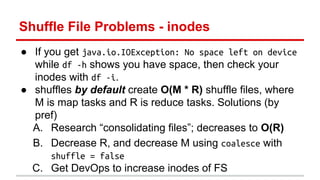This document discusses common technical problems encountered when building products with Spark and provides solutions. It covers Spark exceptions like out of memory errors and shuffle file problems. It recommends increasing partitions and memory configurations. The document also discusses optimizing Spark code using functional programming principles like strong and weak pipelining, and leveraging monoid structures to reduce shuffling. Overall it provides tips to debug issues, optimize performance, and productize Spark applications.










![Definition - Strongly Pipelineable
Let x: RDD[T], let M := < m1, …, mn> be a valid sequence of
method invocations on x with parameters, i.e.
“x.m1. … .mn” is a valid line of code, then we say the
sequence M is strongly pipelineable if and only if there
exists a function f such that “x.flatMap(f)” is an
‘equivalent’ line of code.
Definition - Weakly Pipelineable
… and M is weakly pipelineable if and only if there exists a
function f such that “x.mapPartitions(f)” is an ‘equivalent’
line of code.](https://image.slidesharecdn.com/sparkmeetuptalkfinal-141002040142-phpapp02/85/Spark-4th-Meetup-Londond-Building-a-Product-with-Spark-11-320.jpg)



![Example 1
val docIdWords: RDD[(Int, MultiSet[String])]
// 2 stage job
val docIdToIndexesAndNum = docIdWords.mapValues(_.map(getIndex))
.reduceByKey(_ ++ _)
.mapValues(indexes => (indexes, indexes.size))
// 1 stage job
val docIdToIndexesAndNum = docIdWords.mapValues(_.map(getIndex))
.mapValues(indexes => (indexes, indexes.size))
.reduceByKey(addEachTupleElementTogether)](https://image.slidesharecdn.com/sparkmeetuptalkfinal-141002040142-phpapp02/85/Spark-4th-Meetup-Londond-Building-a-Product-with-Spark-15-320.jpg)
![Example 2
val xvalResults: RDD[(Classification, Confusion)]
// Induces 2 stages
val truePositives = xvalResults.filter(_._2 == TP).count()
val trueNegatives = xvalResults.filter(_._2 == TN).count()
// Induces 1 stage (and still easily readable!)
val (truePositives, trueNegatives) = xvalResults.map(_._2).map {
case `TP` => (1, 0)
case `TN` => (0, 1)
}
.reduce(addEachTupleElementTogether)
Seems addEachTupleElementTogether is a recurring theme?! Hmm ...](https://image.slidesharecdn.com/sparkmeetuptalkfinal-141002040142-phpapp02/85/Spark-4th-Meetup-Londond-Building-a-Product-with-Spark-16-320.jpg)



![BY THE POWER OF MONOID!!!
case class MaxMin(max: Int, min: Int)
object MaxMin {
def apply(pair: (Int, Int)) = MaxMin(pair._1, pair._2)
def apply(i: Int) = MaxMin(i, i)
implicit object MaxMinMonoid extends Monoid[MaxMin] {
def zero: MaxMin = MaxMin(Int.MinValue, Int.MaxValue)
def append(mm1: MaxMin, mm2: => MaxMin): MaxMin = MaxMin(
if (mm1.max > mm2.max) mm1.max else mm2.max,
if (mm1.min < mm2.min) mm1.min else mm2.min
)
}](https://image.slidesharecdn.com/sparkmeetuptalkfinal-141002040142-phpapp02/85/Spark-4th-Meetup-Londond-Building-a-Product-with-Spark-20-320.jpg)
![Example 3
implicit class PimpedIntRDD(rdd: RDD[Int]) {
// Twice as fast as doing rdd.top(1) - rdd.top(1)(reverseOrd)
def range: Int = {
val MaxMin(max, min) = rdd.map(MaxMin.apply).reduce(_ |+| _)
max - min
}
// Similarly faster than doing rdd.reduce(_ + _) / rdd.count()
def average: Double = {
val (sum, total) = rdd.map((_, 1)).reduce(_ |+| _)
sum.toDouble / total
}
// TODO Using generics and type-classes much of what we have done
// can be extended to include all Numeric types easily](https://image.slidesharecdn.com/sparkmeetuptalkfinal-141002040142-phpapp02/85/Spark-4th-Meetup-Londond-Building-a-Product-with-Spark-21-320.jpg)
![Example 4
val rdd: RDD[MyKey, Int] = ...
// BAD! Shuffles a lot of data and traverses each group twice
val ranges: RDD[MyKey, Int] =
rdd.groupByKey().mapValues(seq => seq.max - seq.min)
val ranges = rdd.mapValues(MaxMin.apply).reduceByKey(_ |+| _) // GOOD!
Let B be number of Bytes shuffled accross the network
Let N be num records, K num keys, and W num worker nodes
Let X be the relative size of an element of the monoid to the base records
E.g. here a MaxMin is ~twice the size of the records
Then in general for a groupByKey B is O(N(1 - 1/W)),
for a “monoidally refactored” reduceByKey B is O((W - 1)KX)
E.g. for the above, if N = 1,000,000, W = 10, K = 100, then monoid version
has net-IO complexity 500x less.](https://image.slidesharecdn.com/sparkmeetuptalkfinal-141002040142-phpapp02/85/Spark-4th-Meetup-Londond-Building-a-Product-with-Spark-22-320.jpg)
![Scalaz out of box Monoids
Supports:
● Some Numerics (e.g. Int) and collections (e.g. List)
● Tuples of monoids (go back to Example 1 & 2 for a use)
● Option of a monoid
● Map[A, B] where B is a monoid (really cool, you must
google!), useful as sparse vectors, datacubes, sparse
histograms, etc.
See also com.twitter.algebird](https://image.slidesharecdn.com/sparkmeetuptalkfinal-141002040142-phpapp02/85/Spark-4th-Meetup-Londond-Building-a-Product-with-Spark-23-320.jpg)

![Super Unit Testing!
With just two lines of code we can unit test our monoids for
100s of test cases
implicit val _: Arbitrary[MaxMin] =
Arbitrary(for (ij <- arbitrary[(Int, Int)]) yield MaxMin(ij))
checkAll(monoid.laws[MaxMin])
// Strictly speaking we need to define commutativeMonoid.laws
Conclusion - Functional Programming in Scala
Much faster, more readable, generic, modular, succinct,
type-safe code that has insane test coverage practically for
free!](https://image.slidesharecdn.com/sparkmeetuptalkfinal-141002040142-phpapp02/85/Spark-4th-Meetup-Londond-Building-a-Product-with-Spark-25-320.jpg)


